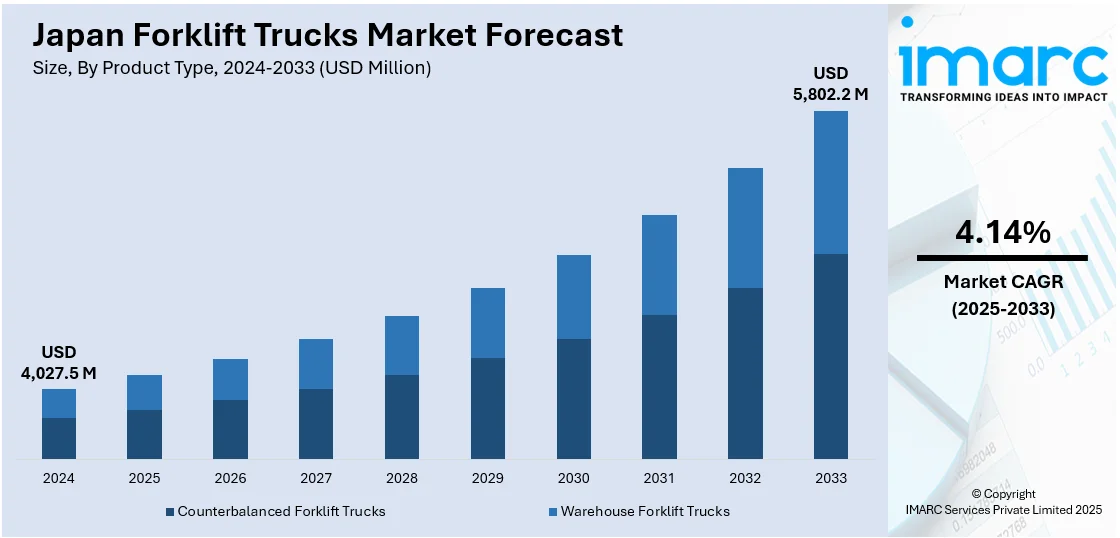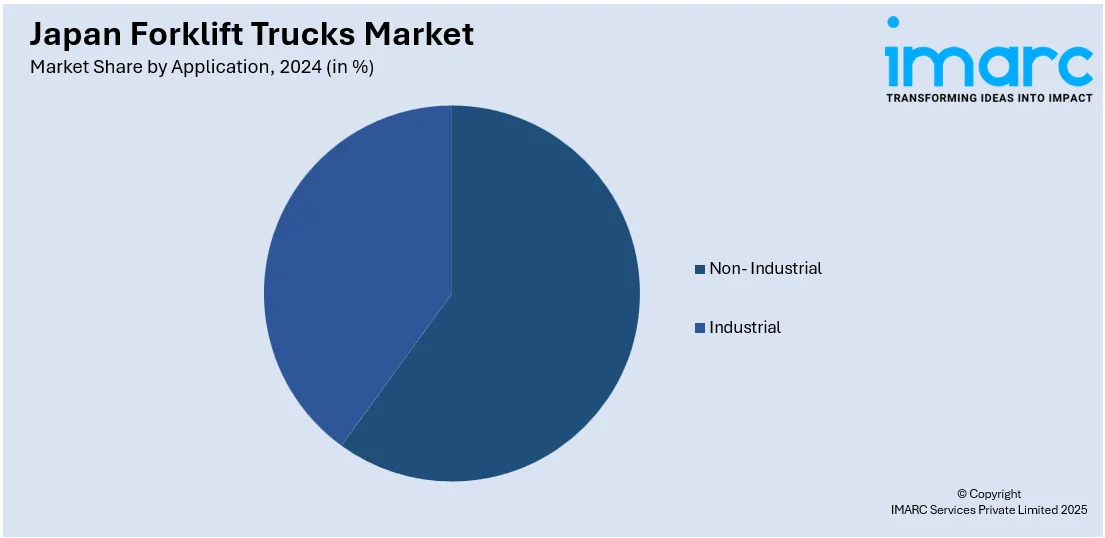
Japan Forklift Trucks Market Size, Share, Trends and Forecast by Product Type, Technology, Class, Application, and Region, 2025-2033
Japan Forklift Trucks Market Overview:
The Japan forklift trucks market size reached USD 4,027.5 Million in 2024. Looking forward, IMARC Group expects the market to reach USD 5,802.2 Million by 2033, exhibiting a growth rate (CAGR) of 4.14% during 2025-2033. The rising demand from e-commerce, increasing warehouse automation, expanding manufacturing sector, government support for industrial growth, growing need for efficient material handling, advancements in electric forklift technology, emphasis on workplace safety, urban infrastructure development, and increasing focus on sustainability are key drivers expanding Japan forklift trucks market share.
|
Report Attribute
|
Key Statistics
|
|---|---|
|
Base Year
|
2024
|
|
Forecast Years
|
2025-2033
|
|
Historical Years
|
2019-2024
|
| Market Size in 2024 | USD 4,027.5 Million |
| Market Forecast in 2033 | USD 5,802.2 Million |
| Market Growth Rate 2025-2033 | 4.14% |
Japan Forklift Trucks Market Trends:
Shift Toward Electric and Eco-Friendly Forklifts
The shift towards electric and eco-friendly models is creating a positive Japan forklift trucks market outlook. Moreover, companies are investing more in battery-powered forklifts, propelled by the nation's efforts to cut carbon emissions and comply with international climate agreements. According to an industry report, with the global goal of net zero by 2050, Japan aims to reduce its greenhouse gas emissions by 60% by 2035. These national targets are pushing industries to adopt cleaner, more energy-efficient machinery across their logistics and production operations. Electric forklifts have various benefits over conventional internal combustion (IC) engine forklifts, such as lower noise emissions, lower maintenance costs, and zero on-site emissions, making them ideal for indoor and city-center usage. As there is increased environmental awareness and stricter emissions regulations by the Japanese government, conventional internal combustion (IC) engine forklifts are being phased out incrementally. In addition, technological advancements in lithium-ion battery technology have enhanced the energy efficiency and lifespan of electric forklifts, overcoming previous disadvantages like lengthy charging times and short operating cycles. Also, key players in the market are increasing their range of electric forklifts to cater to changing needs. This transition becomes consonant with wider corporate sustainability objectives, and electric forklifts are becoming a strategic purchase for logistics and warehousing companies with bases in Japan.

Integration of Automation and Smart Technologies
Automation and smart technologies are becoming integral to forklift truck operations in Japan, reflecting the broader trend of Industry 4.0. The increasing adoption of automated guided vehicles (AGVs) and semi-autonomous forklifts is transforming logistics and warehouse management. These smart forklift trucks, equipped with sensors, cameras, and GPS systems, enable real-time data tracking, obstacle detection, and route optimization, significantly enhancing operational efficiency and safety. For example, on December 12, 2024, Mitsubishi Heavy Industries (MHI) and Mitsubishi Logisnext announced the full implementation of their automated picking solution, utilizing the ΣSynX system, at Kirin Group's Ebina Logistics Center in Kanagawa Prefecture. This marks Japan's first deployment of such a system, which efficiently coordinates Automated Guided Forklifts (AGFs), Automated Guided Vehicles (AGVs), and palletizers to enhance warehouse operations. The initiative addresses challenges in logistics, including labor shortages and heavy manual tasks, by automating picking processes and improving throughput. Additionally, the integration of Internet of Things (IoT) technologies allows fleet managers to monitor forklift usage, battery health, and maintenance needs remotely, improving decision-making and minimizing downtime. The growing demand for high-throughput operations, especially in the e-commerce and retail sectors, continues to push the adoption of these intelligent material handling solutions, thereby driving Japan forklift trucks market growth.
Japan Forklift Trucks Market Segmentation:
IMARC Group provides an analysis of the key trends in each segment of the market, along with forecasts at the country level for 2025-2033. Our report has categorized the market based on product type, technology, class, and application.
Product Type Insights:
- Counterbalanced Forklift Trucks
- Warehouse Forklift Trucks
The report has provided a detailed breakup and analysis of the market based on the product type. This includes counterbalanced forklift trucks and warehouse forklift trucks.
Technology Insights:
- Electricity Problem
- Internal Combustion Engine Powered
A detailed breakup and analysis of the market based on the technology have also been provided in the report. This includes electricity problem and internal combustion engine powered.
Class Insights:
- Class I
- Class II
- Class III
- Class IV
- Class V
The report has provided a detailed breakup and analysis of the market based on the class. This includes class I, class II, class III, class IV, and class V.
Application Insights:

- Non- Industrial
- Warehouse and Distribution Centers
- Construction Sites
- Dockyards
- Snow Plows
- Industrial
- Manufacturing
- Recycling Operations
A detailed breakup and analysis of the market based on the application have also been provided in the report. This includes non-industrial (warehouse and distribution centers, construction sites, dockyards, and snow plows) and industrial (manufacturing and recycling operations).
Regional Insights:
- Kanto Region
- Kansai/Kinki Region
- Central/ Chubu Region
- Kyushu-Okinawa Region
- Tohoku Region
- Chugoku Region
- Hokkaido Region
- Shikoku Region
The report has also provided a comprehensive analysis of all the major regional markets, which include Kanto Region, Kansai/Kinki Region, Central/Chubu Region, Kyushu-Okinawa Region, Tohoku Region, Chugoku Region, Hokkaido Region, and Shikoku Region.
Competitive Landscape:
The market research report has also provided a comprehensive analysis of the competitive landscape. Competitive analysis such as market structure, key player positioning, top winning strategies, competitive dashboard, and company evaluation quadrant has been covered in the report. Also, detailed profiles of all major companies have been provided.
Japan Forklift Trucks Market News:
- On July 23, 2024, Toyota Material Handling Japan (TMHJ) and Fujitsu announced the joint development of Japan's first AI-based forklift driving analysis service. This cloud-based solution evaluates forklift driving safety by analyzing dash camera footage with AI trained on forklift maneuvers and operator behaviors, automatically detecting unsafe operations and generating safety scorecards for each operator. The service aims to streamline safety evaluations, support operator training, and enhance safety awareness in logistics environments.
- On February 18, 2025, Sumitomo NACCO Forklift partnered with Swiss automation leader BlueBotics to develop the Pickio Pallet Picker, an automated guided forklift (AGF) integrating BlueBotics' ANT navigation technology and ANT server fleet management software. This ride-on, hybrid system is designed for flat picking areas and can adjust to the height of transported goods, aiming to reduce labor in picking operations. The collaboration underscores Sumitomo NACCO's commitment to enhancing precision and usability in automated vehicle offerings for Japanese enterprises.
Japan Forklift Trucks Market Report Coverage:
| Report Features | Details |
|---|---|
| Base Year of the Analysis | 2024 |
| Historical Period | 2019-2024 |
| Forecast Period | 2025-2033 |
| Units | Million USD |
| Scope of the Report |
Exploration of Historical Trends and Market Outlook, Industry Catalysts and Challenges, Segment-Wise Historical and Future Market Assessment:
|
| Product Types Covered | Counterbalanced Forklift Trucks, Warehouse Forklift Trucks |
| Technologies Covered | Electricity Problem, Internal Combustion Engine Powered |
| Classes Covered | Class I, Class II, Class III, Class IV, Class V |
| Applications Covered |
|
| Regions Covered | Kanto Region, Kansai/Kinki Region, Central/Chubu Region, Kyushu-Okinawa Region, Tohoku Region, Chugoku Region, Hokkaido Region, Shikoku Region |
| Customization Scope | 10% Free Customization |
| Post-Sale Analyst Support | 10-12 Weeks |
| Delivery Format | PDF and Excel through Email (We can also provide the editable version of the report in PPT/Word format on special request) |
Key Questions Answered in This Report:
- How has the Japan forklift trucks market performed so far and how will it perform in the coming years?
- What is the breakup of the Japan forklift trucks market on the basis of product type?
- What is the breakup of the Japan forklift trucks market on the basis of technology?
- What is the breakup of the Japan forklift trucks market on the basis of class?
- What is the breakup of the Japan forklift trucks market on the basis of application?
- What is the breakup of the Japan forklift trucks market on the basis of region?
- What are the various stages in the value chain of the Japan forklift trucks market?
- What are the key driving factors and challenges in the Japan forklift trucks?
- What is the structure of the Japan forklift trucks market and who are the key players?
- What is the degree of competition in the Japan forklift trucks market?
Key Benefits for Stakeholders:
- IMARC’s industry report offers a comprehensive quantitative analysis of various market segments, historical and current market trends, market forecasts, and dynamics of the Japan forklift trucks market from 2019-2033.
- The research report provides the latest information on the market drivers, challenges, and opportunities in the Japan forklift trucks market.
- Porter's five forces analysis assist stakeholders in assessing the impact of new entrants, competitive rivalry, supplier power, buyer power, and the threat of substitution. It helps stakeholders to analyze the level of competition within the Japan forklift trucks industry and its attractiveness.
- Competitive landscape allows stakeholders to understand their competitive environment and provides an insight into the current positions of key players in the market.
Need more help?
- Speak to our experienced analysts for insights on the current market scenarios.
- Include additional segments and countries to customize the report as per your requirement.
- Gain an unparalleled competitive advantage in your domain by understanding how to utilize the report and positively impacting your operations and revenue.
- For further assistance, please connect with our analysts.
 Request Customization
Request Customization
 Speak to an Analyst
Speak to an Analyst
 Request Brochure
Request Brochure
 Inquire Before Buying
Inquire Before Buying




.webp)




.webp)












